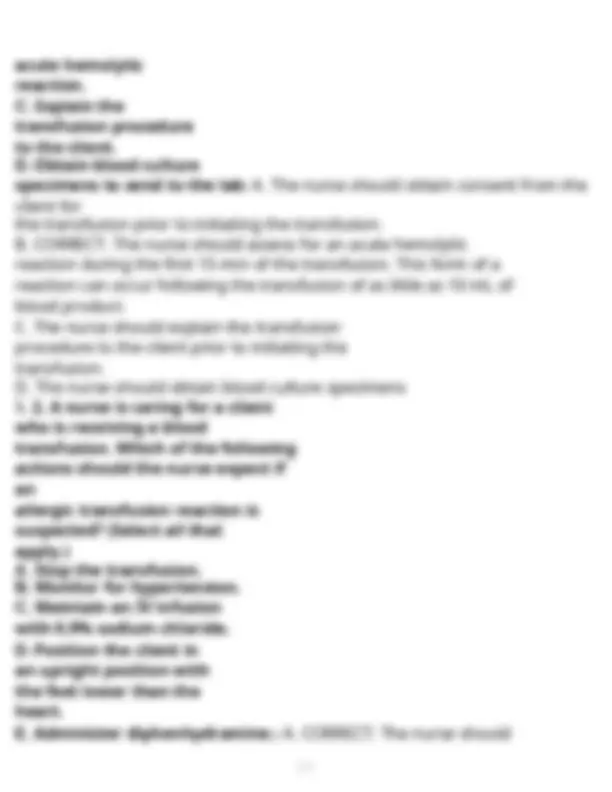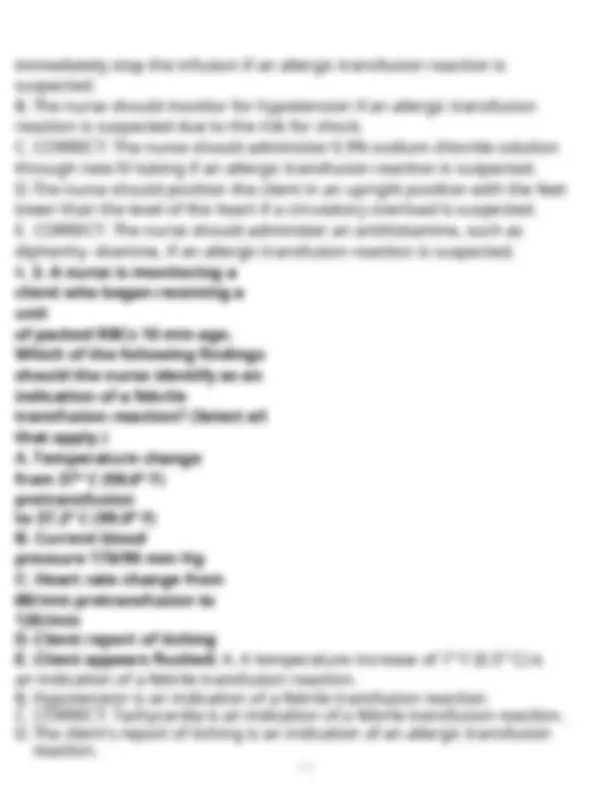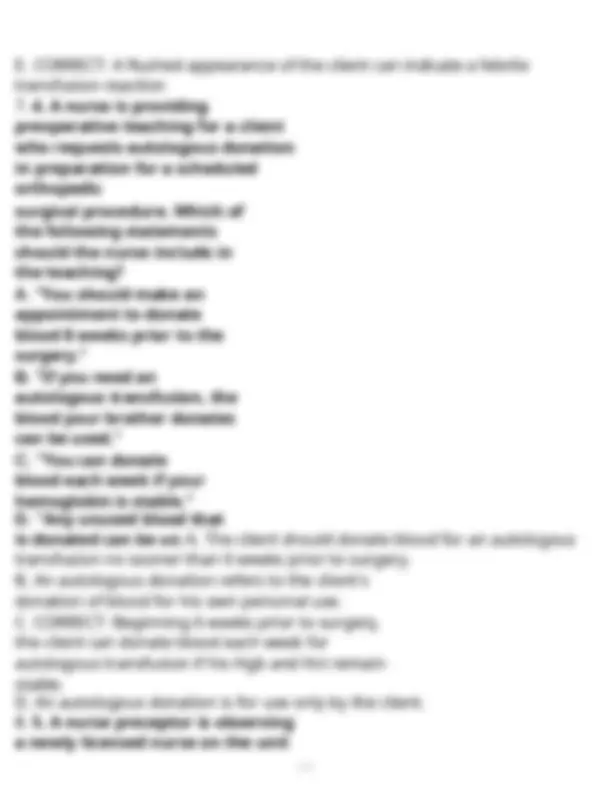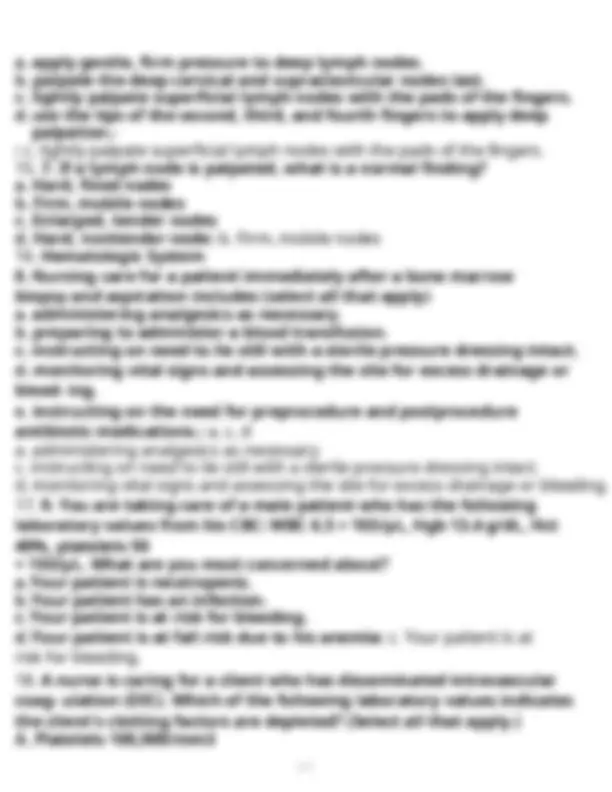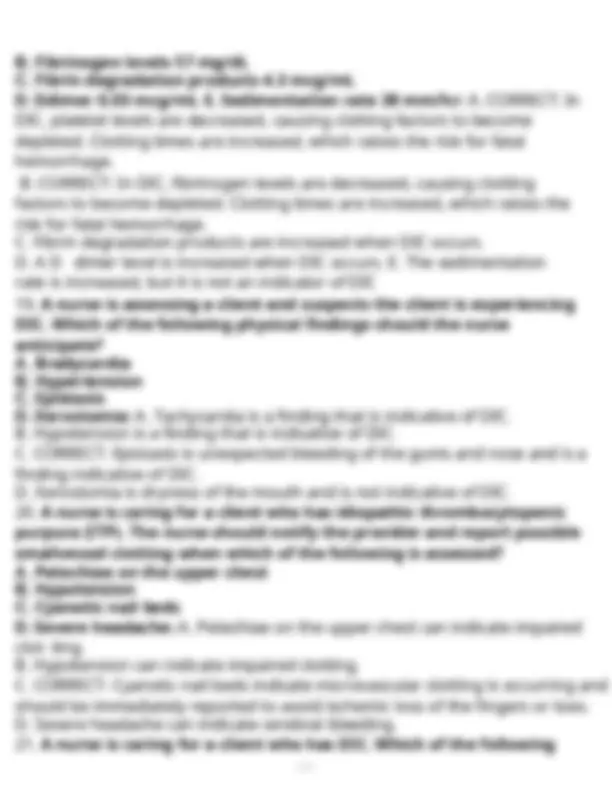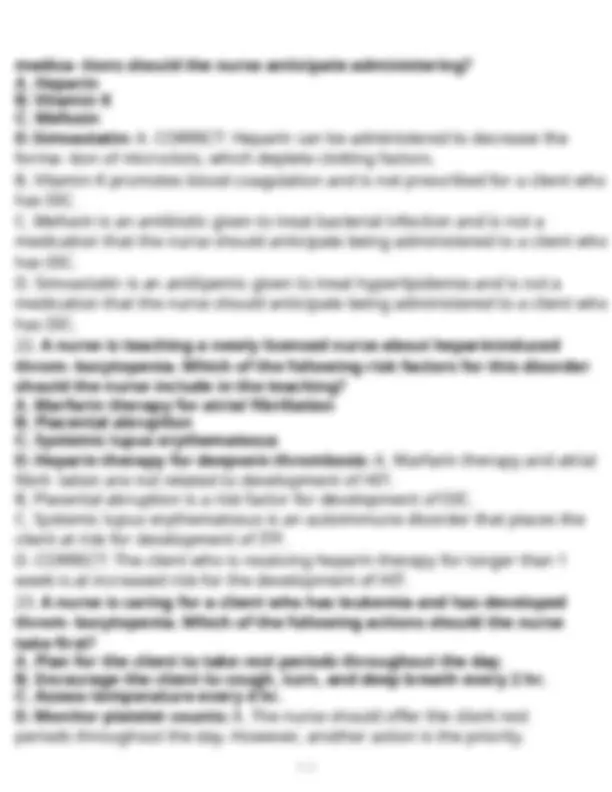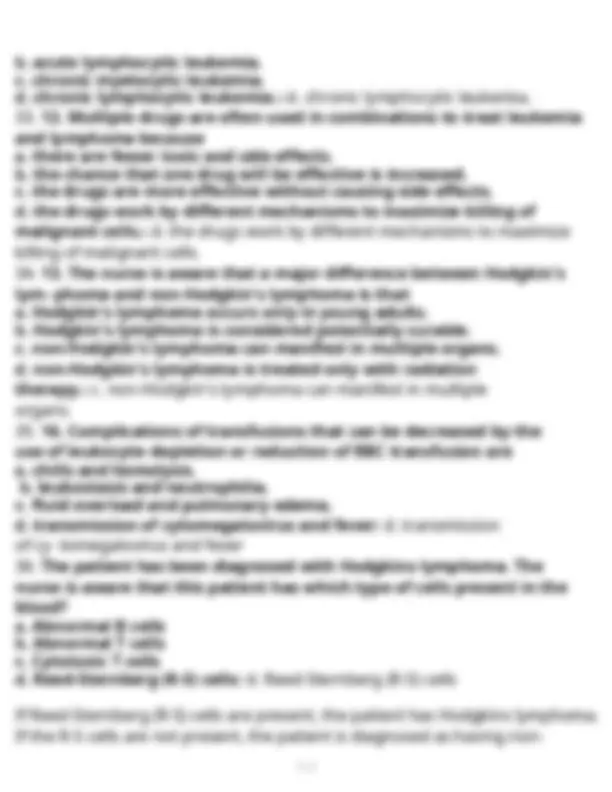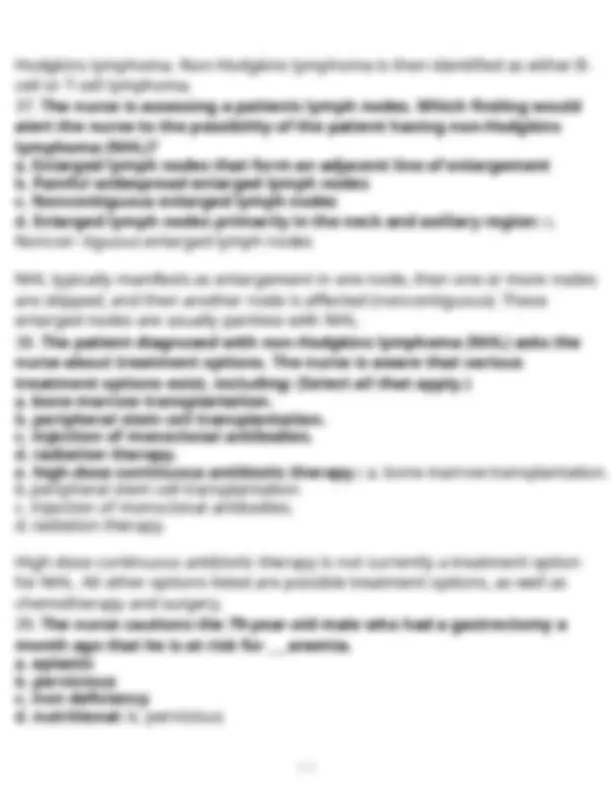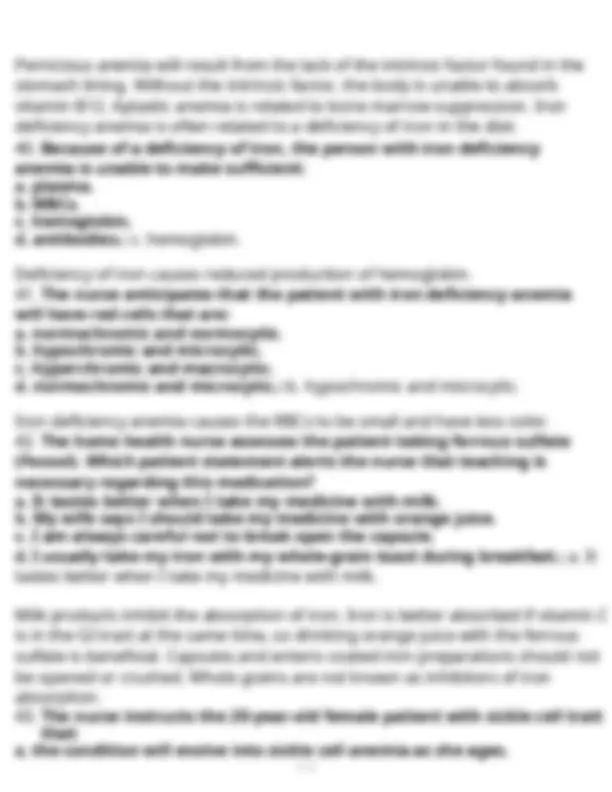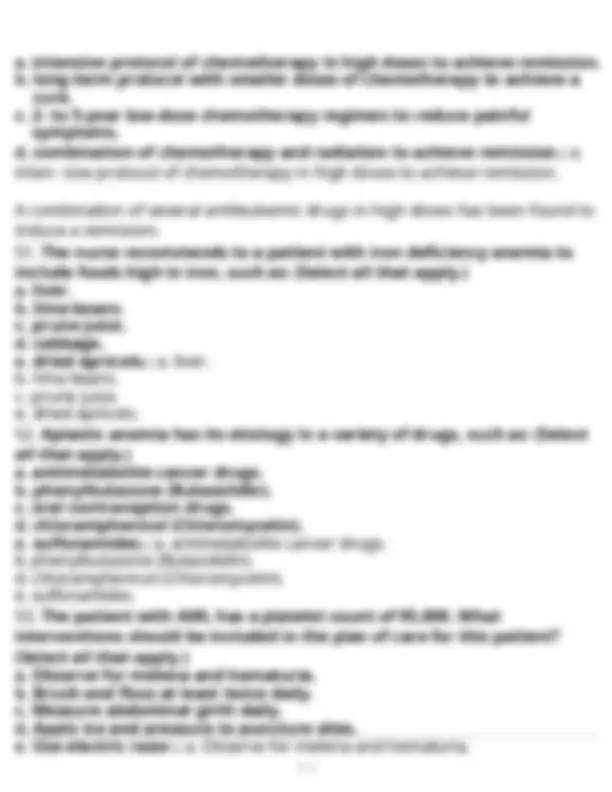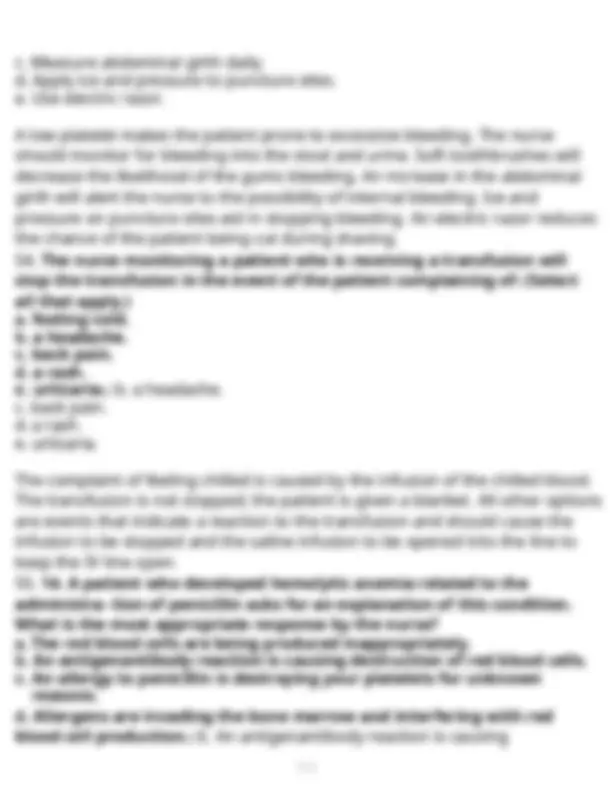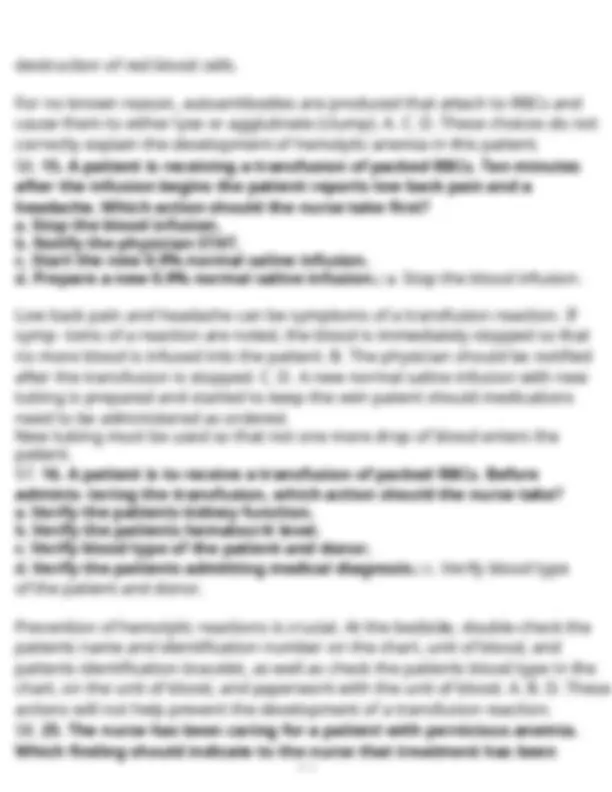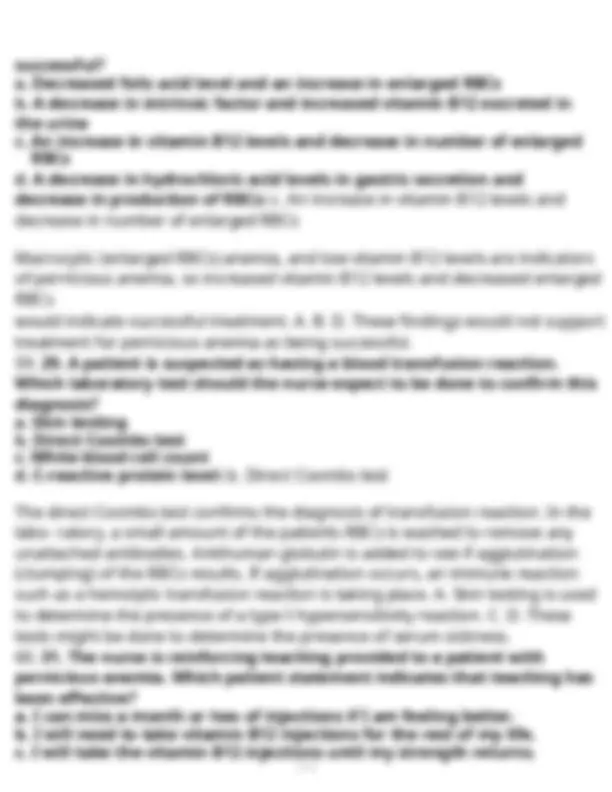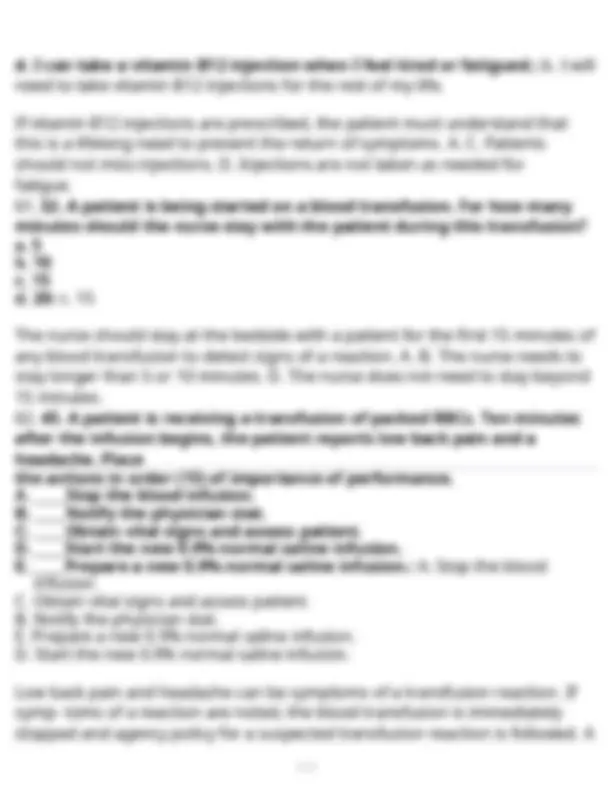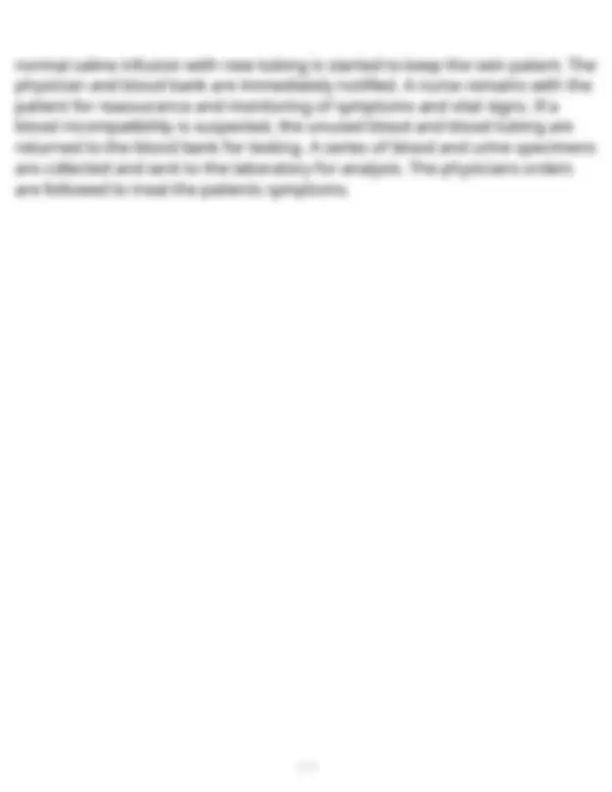Download Hematology NCLEX questions updated revised with answers A+ graded and more Exams Nursing in PDF only on Docsity!
Hematology NCLEX questions updated revised with
answers A+ graded
- A nurse in a clinic is caring for a client who has suspected anemia. Which of the following laboratory test results should the nurse expect? A. Iron 90 mcg/dL B. RBC 6.5 million/uL C. WBC 4,800 mm D. Hgb 10 g/dL: A. An iron level of 90 mcg/dL is within the expected reference range and is not an expected finding of anemia. B. RBC count of 6.5 million/uL is above the expected reference range. A decreased RBC count is an expected finding of anemia. C. WBC count of 4800 mm is below the expected reference range and is not an expected finding of anemia. D. CORRECT: Hgb of 10 g/dL is below the expected reference range and is an expected finding of anemia.
- A nurse is caring for a client who is receiving warfarin for anticoagulation therapy. Which of the following laboratory test results indicates to the nurse that the client needs an increase in the dosage? A. aPTT 38 seconds B. INR 1. C. PT 22 seconds D. Ddimer negative: A. aPTT is monitored for clients receiving heparin therapy. An aPTT of 38 seconds is within the expected reference range for clients not receiving heparin therapy. B. CORRECT: INR of 1.1 is within the expected reference range for a client who is not receiving warfarin. However, this value is subtherapeutic for anticoagulation therapy. The nurse should expect the client to receive an increased dosage of warfarin until the INR is 2 to 3. C. PT of 22 seconds is above the expected reference range for a client
receiving warfarin therapy. This result indicates the client is at an increased risk for bleeding. D. A negative D dimer test indicates the absence of a pulmonary embolus or deep vein thrombosis and is not used to determine the dosage needs for warfarin therapy.
- A nurse is providing teaching for a client who is scheduled for a bone marrow biopsy of the iliac crest. Which of the following statements made by the client indicates an understanding of the teaching? A. "This test will be performed while I am lying flat on my back." B. "I will need to stay in bed for about an hour after the test." C. "This test will determine which antibiotic I should take for treatment." D. "I will receive general anesthesia for the test.": A. The nurse should inform the client that he will be placed in a prone or side lying position during the test in order to expose the iliac crest. B. CORRECT: The nurse should inform the client of the need to stay on bed rest for 30 to 60 min following the test to reduce the risk for bleeding. C. The nurse should inform the client that a culture and sensitivity test determines the type of antibiotics needed to treat an infection. D. The nurse should inform the client that he will receive a sedative prior to the test and that a local anesthetic will be used at the site.
- A nurse is preparing to administer packed RBCs to a client who has a Hgb of 8 g/dL. Which of the following actions should the nurse plan to take during the first 15 min of the transfusion? A. Obtain consent from the client for the transfusion. B. Assess for an
immediately stop the infusion if an allergic transfusion reaction is suspected. B. The nurse should monitor for hypotension if an allergic transfusion reaction is suspected due to the risk for shock. C. CORRECT: The nurse should administer 0.9% sodium chloride solution through new IV tubing if an allergic transfusion reaction is suspected. D.The nurse should position the client in an upright position with the feet lower than the level of the heart if a circulatory overload is suspected. E. CORRECT: The nurse should administer an antihistamine, such as diphenhy- dramine, if an allergic transfusion reaction is suspected.
- A nurse is monitoring a client who began receiving a unit of packed RBCs 10 min ago. Which of the following findings should the nurse identify as an indication of a febrile transfusion reaction? (Select all that apply.) A. Temperature change from 37° C (98.6° F) pretransfusion to 37.2° C (99.0° F) B. Current blood pressure 178/90 mm Hg C. Heart rate change from 88/min pretransfusion to 120/min D. Client report of itching E. Client appears flushed: A. A temperature increase of 1° F (0.5° C) is an indication of a febrile transfusion reaction. B. Hypotension is an indication of a febrile transfusion reaction. C. CORRECT: Tachycardia is an indication of a febrile transfusion reaction. D. The client's report of itching is an indication of an allergic transfusion reaction.
E. CORRECT: A flushed appearance of the client can indicate a febrile transfusion reaction
- A nurse is providing preoperative teaching for a client who requests autologous donation in preparation for a scheduled orthopedic surgical procedure. Which of the following statements should the nurse include in the teaching? A. "You should make an appointment to donate blood 8 weeks prior to the surgery." B. "If you need an autologous transfusion, the blood your brother donates can be used." C. "You can donate blood each week if your hemoglobin is stable." D. "Any unused blood that is donated can be us: A. The client should donate blood for an autologous transfusion no sooner than 6 weeks prior to surgery. B. An autologous donation refers to the client's donation of blood for his own personal use. C. CORRECT: Beginning 6 weeks prior to surgery, the client can donate blood each week for autologous transfusion if his Hgb and Hct remain stable. D. An autologous donation is for use only by the client.
- A nurse preceptor is observing a newly licensed nurse on the unit
reaction.
- An individual who lives at a high altitude may normally have an increased RBC count because a. high altitudes cause vascular fluid loss, leading to hemoconcentration. b. hypoxia caused by decreased atmospheric oxygen stimulates erythro- poiesis. c. the function of the spleen in removing old RBCs is impaired at high alti- tudes. d. impaired production of leukocytes and platelets leads to proportionally higher red cell counts.: b. hypoxia caused by decreased atmospheric oxygen stimulates erythropoiesis.
- Malignant disorders that arise from granulocytic cells in the bone mar- row will have the primary effect of causing a. risk for hemorrhage. b. altered oxygenation. c. decreased production of antibodies. d. decreased phagocytosis of bacteria.: d. decreased phagocytosis of bacteria.
- An anticoagulant such as warfarin (Coumadin) that interferes with pro- thrombin production will alter the clotting mechanism during a. platelet aggregation. b. activation of thrombin. c. the release of tissue thromboplastin. d. stimulation of factor activation comple: b. activation of thrombin.
- When reviewing laboratory results of an 83-year-old patient with an infection, the nurse would expect to find a. minimal leukocytosis. b. decreased platelet count. c. increased hemoglobin and hematocrit levels. d. decreased erythrocyte sedimentation rate (ESR).: a. minimal leukocytosis.
- Significant information obtained from the patient's health history that relates to the hematologic system includes a. jaundice. b. bladder surgery. c. early menopause. d. multiple pregnancies.: a. jaundice.
- While assessing the lymph nodes, the nurse should
a. apply gentle, firm pressure to deep lymph nodes. b. palpate the deep cervical and supraclavicular nodes last. c. lightly palpate superficial lymph nodes with the pads of the fingers. d. use the tips of the second, third, and fourth fingers to apply deep palpation.- : c. lightly palpate superficial lymph nodes with the pads of the fingers.
- If a lymph node is palpated, what is a normal finding? a. Hard, fixed nodes b. Firm, mobile nodes c. Enlarged, tender nodes d. Hard, nontender node: b. Firm, mobile nodes
- Hematologic System 8. Nursing care for a patient immediately after a bone marrow biopsy and aspiration includes (select all that apply) a. administering analgesics as necessary. b. preparing to administer a blood transfusion. c. instructing on need to lie still with a sterile pressure dressing intact. d. monitoring vital signs and assessing the site for excess drainage or bleed- ing. e. instructing on the need for preprocedure and postprocedure antibiotic medications.: a, c, d a. administering analgesics as necessary. c. instructing on need to lie still with a sterile pressure dressing intact. d. monitoring vital signs and assessing the site for excess drainage or bleeding.
- You are taking care of a male patient who has the following laboratory values from his CBC: WBC 6.5 × 103/μL, Hgb 13.4 g/dL, Hct 40%, platelets 50 × 103/μL. What are you most concerned about? a. Your patient is neutropenic. b. Your patient has an infection. c. Your patient is at risk for bleeding. d. Your patient is at fall risk due to his anemia: c. Your patient is at risk for bleeding.
- A nurse is caring for a client who has disseminated intravascular coag- ulation (DIC). Which of the following laboratory values indicates the client's clotting factors are depleted? (Select all that apply.) A. Platelets 100,000/mm
medica- tions should the nurse anticipate administering? A. Heparin B. Vitamin K C. Mefoxin D. Simvastatin: A. CORRECT: Heparin can be administered to decrease the forma- tion of microclots, which deplete clotting factors. B. Vitamin K promotes blood coagulation and is not prescribed for a client who has DIC. C. Mefoxin is an antibiotic given to treat bacterial infection and is not a medication that the nurse should anticipate being administered to a client who has DIC. D. Simvastatin is an antilipemic given to treat hyperlipidemia and is not a medication that the nurse should anticipate being administered to a client who has DIC.
- A nurse is teaching a newly licensed nurse about heparininduced throm- bocytopenia. Which of the following risk factors for this disorder should the nurse include in the teaching? A. Warfarin therapy for atrial fibrillation B. Placental abruption C. Systemic lupus erythematosus D. Heparin therapy for deepvein thrombosis: A. Warfarin therapy and atrial fibril- lation are not related to development of HIT. B. Placental abruption is a risk factor for development of DIC. C. Systemic lupus erythematosus is an autoimmune disorder that places the client at risk for development of ITP. D. CORRECT: The client who is receiving heparin therapy for longer than 1 week is at increased risk for the development of HIT.
- A nurse is caring for a client who has leukemia and has developed throm- bocytopenia. Which of the following actions should the nurse take first? A. Plan for the client to take rest periods throughout the day. B. Encourage the client to cough, turn, and deep breath every 2 hr. C. Assess temperature every 4 hr. D. Monitor platelet counts: A. The nurse should offer the client rest periods throughout the day. However, another action is the priority.
B. The nurse should encourage the client to cough, turn and deep breathe every 2 hr. However, another action is the priority. C. The nurse should assess the client's temperature every 4 hr. However, another action is the priority D. CORRECT: The greatest risk to the client who has thrombocytopenia is injury due to bleeding. The priority action for the nurse to take is to initiate bleeding precautions, such monitoring platelet count.
- In a severely anemic patient, the nurse would expect to find a. dyspnea and tachycardia. b. cyanosis and pulmonary edema. c. cardiomegaly and pulmonary fibrosis. d. ventricular dysrhythmias and wheezing.: a. dyspnea and tachycardia.
- When obtaining assessment data from a patient with a microcytic, hypochromic anemia, the nurse would question the patient about a. folic acid intake. b. dietary intake of iron. c. a history of gastric surgery. d. a history of sickle cell anemia: b. dietary intake of iron.
- Nursing interventions for a patient with severe anemia related to peptic ulcer disease include (select all that apply) a. monitoring stools for guaiac. b. instructions for high-iron diet. c. taking vital signs every 8 hours. d. teaching self-injection of erythropoietin. e. administration of cobalamin (vitamin B12) injections.: a. monitoring stools for guaiac. b. instructions for high-iron diet.
- The nursing management of a patient in sickle cell crisis includes (select all that apply) a. monitoring CBC. b. optimal pain management and O2 therapy. c. blood transfusions if required and iron chelation. d. rest as needed and deep vein thrombosis prophylaxis. e. administration of IV iron and diet high in iron content.: a. monitoring CBC. b. optimal pain management and O2 therapy.
b. acute lymphocytic leukemia. c. chronic myelocytic leukemia. d. chronic lymphocytic leukemia.: d. chronic lymphocytic leukemia.
- Multiple drugs are often used in combinations to treat leukemia and lymphoma because a. there are fewer toxic and side effects. b. the chance that one drug will be effective is increased. c. the drugs are more effective without causing side effects. d. the drugs work by different mechanisms to maximize killing of malignant cells.: d. the drugs work by different mechanisms to maximize killing of malignant cells.
- The nurse is aware that a major difference between Hodgkin's lym- phoma and non-Hodgkin's lymphoma is that a. Hodgkin's lymphoma occurs only in young adults. b. Hodgkin's lymphoma is considered potentially curable. c. non-Hodgkin's lymphoma can manifest in multiple organs. d. non-Hodgkin's lymphoma is treated only with radiation therapy.: c. non-Hodgkin's lymphoma can manifest in multiple organs.
- Complications of transfusions that can be decreased by the use of leukocyte depletion or reduction of RBC transfusion are a. chills and hemolysis. b. leukostasis and neutrophilia. c. fluid overload and pulmonary edema. d. transmission of cytomegalovirus and fever: d. transmission of cy- tomegalovirus and fever
- The patient has been diagnosed with Hodgkins lymphoma. The nurse is aware that this patient has which type of cells present in the blood? a. Abnormal B cells b. Abnormal T cells c. Cytotoxic T cells d. Reed-Sternberg (R-S) cells: d. Reed-Sternberg (R-S) cells If Reed-Sternberg (R-S) cells are present, the patient has Hodgkins lymphoma. If the R-S cells are not present, the patient is diagnosed as having non-
Hodgkins lymphoma. Non-Hodgkins lymphoma is then identified as either B- cell or T-cell lymphoma.
- The nurse is assessing a patients lymph nodes. Which finding would alert the nurse to the possibility of the patient having non-Hodgkins lymphoma (NHL)? a. Enlarged lymph nodes that form an adjacent line of enlargement b. Painful widespread enlarged lymph nodes c. Noncontiguous enlarged lymph nodes d. Enlarged lymph nodes primarily in the neck and axillary region: c. Noncon- tiguous enlarged lymph nodes NHL typically manifests as enlargement in one node, then one or more nodes are skipped, and then another node is affected (noncontiguous). These enlarged nodes are usually painless with NHL.
- The patient diagnosed with non-Hodgkins lymphoma (NHL) asks the nurse about treatment options. The nurse is aware that various treatment options exist, including: (Select all that apply.) a. bone marrow transplantation. b. peripheral stem cell transplantation. c. injection of monoclonal antibodies. d. radiation therapy. e. high-dose continuous antibiotic therapy.: a. bone marrow transplantation. b. peripheral stem cell transplantation. c. injection of monoclonal antibodies. d. radiation therapy. High-dose continuous antibiotic therapy is not currently a treatment option for NHL. All other options listed are possible treatment options, as well as chemotherapy and surgery.
- The nurse cautions the 79-year-old male who had a gastrectomy a month ago that he is at risk for anemia. a. aplastic b. pernicious c. iron deficiency d. nutritional: b. pernicious
b. all of her children will have sickle cell anemia. c. the trait will be transmitted to male children only. d. the trait can be passed on to all children.: d. the trait can be passed on to all children. A person who has the trait can pass it on to male or female children, even if there are no symptoms. Fifty percent of the patients total hemoglobin may be affected. Age does not increase the chance of the trait evolving into the disease.
- The nurse stresses to the patient with sickle cell anemia that one of the most elementary home interventions to help prevent sickle cell crisis is to: a. take iron supplements daily. b. maintain adequate fluid intake. c. engage in daily exercise. d. eat leafy green vegetables.: b. maintain adequate fluid intake. The maintenance of an adequate fluid intake keeps the circulating blood volume hydrated, which discourages clumping of the sickle cells
- The nurse is conscientious in the care of the feet and legs of a patient with sickle cell anemia because: a. stasis ulcers are a constant threat. b. bleeding may occur on the soles of the feet. c. edema of the feet increases activity intolerance. d. toenails must be kept short to avoid ingrown nails: a. stasis ulcers are a constant threat. Because of the sluggish flow of blood, stasis ulcers are a constant threat and are very difficult to heal.
- The nurse evaluates a need for further instruction to the patient with sickle cell anemia when he says: a. I know Im not supposed to drink iced drinks. b. I surely do miss my three beers in the afternoon. c. I walk every day rather than doing other strenuous exercise. d. I am looking forward to my annual ski trip to Colorado: d. I am looking forward to my annual ski trip to Colorado
People with sickle cell anemia should avoid cold temperatures and high altitudes, which can bring on a crisis due to thickening of the blood. Avoidance of iced drinks, alcohol, and strenuous exercise is beneficial
- The nurse assessing a patient with polycythemia vera would anticipate: a. pale complexion. b. low blood pressure. c. high hemoglobin. d. normal energy level.: c. high hemoglobin. The person with polycythemia vera will have high hemoglobin and hematocrit related to the large number of red cells. The complexion is ruddy with blue lips; there is fatigue and weakness and high blood pressure.
- The home health nurse caring for the patient with polycythemia vera will focus care on: a. maintenance of high fluid intake. b. daily exercise to reduce weight. c. daily dose of anticoagulants. d. adequate intake of vitamin C.: a. maintenance of high fluid intake. The major focus is maintaining a high fluid intake to keep the circulating fluid well hydrated.
- The patient with acute myelogenous leukemia (AML) asks why he is mak- ing more WBCs when he already has so many. The nurse clarifies that the large number of leukemic white cells he already has: a. are not as effective as normal white cells would be. b. protect against infection. c. attempt to take over the functions of RBCs. d. are produced by the lymphatic system.: a. are not as effective as normal white cells would be. The many leukemic white cells cannot function as normal WBCs do. The bone marrow rushes production of immature white cells (blasts) to try to create adequate protection. These cells do not protect against infection, nor do they take over the functions of the RBCs. AML originates in the bone marrow.
- The nurse explains that induction therapy for acute lymphocytic leukemia (ALL) is a(n):
c. Measure abdominal girth daily. d. Apply ice and pressure to puncture sites. e. Use electric razor. A low platelet makes the patient prone to excessive bleeding. The nurse should monitor for bleeding into the stool and urine. Soft toothbrushes will decrease the likelihood of the gums bleeding. An increase in the abdominal girth will alert the nurse to the possibility of internal bleeding. Ice and pressure on puncture sites aid in stopping bleeding. An electric razor reduces the chance of the patient being cut during shaving.
- The nurse monitoring a patient who is receiving a transfusion will stop the transfusion in the event of the patient complaining of: (Select all that apply.) a. feeling cold. b. a headache. c. back pain. d. a rash. e. urticaria.: b. a headache. c. back pain. d. a rash. e. urticaria. The complaint of feeling chilled is caused by the infusion of the chilled blood. The transfusion is not stopped; the patient is given a blanket. All other options are events that indicate a reaction to the transfusion and should cause the infusion to be stopped and the saline infusion to be opened into the line to keep the IV line open.
- A patient who developed hemolytic anemia related to the administra- tion of penicillin asks for an explanation of this condition. What is the most appropriate response by the nurse? a. The red blood cells are being produced inappropriately. b. An antigenantibody reaction is causing destruction of red blood cells. c. An allergy to penicillin is destroying your platelets for unknown reasons. d. Allergens are invading the bone marrow and interfering with red blood cell production.: b. An antigenantibody reaction is causing
destruction of red blood cells. For no known reason, autoantibodies are produced that attach to RBCs and cause them to either lyse or agglutinate (clump). A. C. D. These choices do not correctly explain the development of hemolytic anemia in this patient.
- A patient is receiving a transfusion of packed RBCs. Ten minutes after the infusion begins the patient reports low back pain and a headache. Which action should the nurse take first? a. Stop the blood infusion. b. Notify the physician STAT. c. Start the new 0.9% normal saline infusion. d. Prepare a new 0.9% normal saline infusion.: a. Stop the blood infusion. Low back pain and headache can be symptoms of a transfusion reaction. If symp- toms of a reaction are noted, the blood is immediately stopped so that no more blood is infused into the patient. B. The physician should be notified after the transfusion is stopped. C. D. A new normal saline infusion with new tubing is prepared and started to keep the vein patent should medications need to be administered as ordered. New tubing must be used so that not one more drop of blood enters the patient.
- A patient is to receive a transfusion of packed RBCs. Before adminis- tering the transfusion, which action should the nurse take? a. Verify the patients kidney function. b. Verify the patients hematocrit level. c. Verify blood type of the patient and donor. d. Verify the patients admitting medical diagnosis.: c. Verify blood type of the patient and donor. Prevention of hemolytic reactions is crucial. At the bedside, double-check the patients name and identification number on the chart, unit of blood, and patients identification bracelet, as well as check the patients blood type in the chart, on the unit of blood, and paperwork with the unit of blood. A. B. D. These actions will not help prevent the development of a transfusion reaction.
- The nurse has been caring for a patient with pernicious anemia. Which finding should indicate to the nurse that treatment has been

